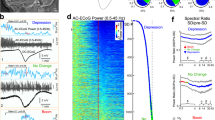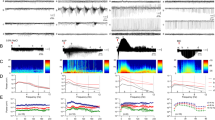Summary
The slow potential change (spc) accompanying spreading depression (SD) was studied in rats and in a seizure-sensitive strain of Mongolian gerbil under three different experimental paradigms, each involving the use of naloxone. Gerbils undergoing electroconvulsive shock treatment displayed SD during the post-ictal phase, which was blocked by the intraperitoneal (i.p.) administration of naloxone (20–50 mg kg-1). Topical application of naloxone to the exposed cortex of the anaesthetized gerbil and rat blocked the spc of SD evoked by KCl. Microiontophoretic ejection of naloxone during extracellular recordings reversed cell refractoriness following the spc, demonstrated by the observation of a maintained sensitivity to iontophoretic pulses of glutamate. The results suggest a possible involvement of naloxone-sensitive processes in the mechanism responsible for cortical SD.
Similar content being viewed by others
References
Bureš J, Hartmann G, Lukyanova LD (1967) Blockade of thalamocortical and pyramidal pathways by striatal spreading depression in rats. Exp Neurol 18: 404–415
Caldecott-Hazard S, Shavit Y, Ackermann RF, Engel J, Frederickson RCA, Liebeskind JC (1982) Behavioural and electrographic effects of opioids on kindled seizures in rats. Brain Res 251: 327–333
de Azeredo FAM, Marques HJA (1982) Spreading depression during the post-ictal period of the convulsive disorder: anticonvulsant effect of sodium valproate. Braz J Med Biol Res 15: 206
Frenk H, Engel J Jr, Ackermann RF, Shavit Y, Liebeskind JC (1979) Endogenous opioids may mediate postictal behavioural depression in amygdaloid kindled rats. Brain Res 167: 435–440
Frenk H, Stein BE (1984) Endogenous opioids mediate ECS-induced catalepsy at supraspinal levels. Brain Res 303: 109–112
Grafstein B (1956) Mechanism of spreading cortical depression. J Neurophysiol 19: 154–171
Guedes RCA (1984) On some conditions that influence cortical spreading depression. Ann Acad Brasil Ciênc 56: 445–455
Guedes RCA, do Carmo RJ (1980) Influence of ionic disturbances by gastric washing on cortical spreading depression. Exp Brain Res 39: 341–349
Holaday JW, Belenky GL (1980) Opiate like effects of electroconvulsive shock in rats: a differential effect of naloxone on nociceptive measures. Life Sci 27: 1929–1938
Hong JS, Gillin JC, Yang IT, Costa E (1979) Repeated electroconvulsive shock and the brain content of endorphines. Brain Res 177: 273–278
Huston JP, Holzhäuer M-S (1987) Behavioral and electrophysiological effects of intracranially applied neuropeptides with special attention to DC slow potential changes. Neural mechanisms and biological significance of grooming behavior. Ann NY Acad Sci (in press)
Kelsey JE, Belluzzi JD (1982) Endorphin mediation of post-ictal effects of kindled seizures in rats. Brain Res 253: 337–340
Krnjević K, Randic M, Straughan DW (1966) An inhibitory process in the cerebral cortex. J Physiol (Lond) 184: 16–48
Leão AAP (1944) Spreading depression of activity in the cerebral cortex. J Neurophysiol 7: 359–390
Leão AAP (1947) Further observations on the spreading depression of activity in the cerebral cortex. J Neurophysiol 10: 409–414
Madison DV, Nicoll RA (1984) Control of the repetitive discharge of rat CA1 pyramidal neurones in vitro. J Physiol (Lond) 354: 319–331
Marques HJA, de Azeredo FAM (1982) Spreading depression during convulsion in unanaesthetized gerbils. Ann Acad Brasil Ciênc 54: 261
Myslobodsky M, Kofman O, Mintz M (1981) Convulsant-specific architecture of the postictal behavior syndrome in the rat. Epilepsia 22: 559–568
Nicoll RA, Alger BE, Jahr CE (1980) Enkephalin blocks inhibitory pathways in the vertebrate CNS. Nature (Lond) 287: 22–25
North RA (1986) Opioid receptor types and membrane ion channels. Trends Neurosci 9: 114–117
Oitzl MS, Koroleva VI, Bureš J (1985) D-Ala2-Metenkephalinamide blocks the synaptically elicited cortical spreading depression in rats. Experientia 41: 625–627
Oitzl MS, Huston JP (1984) Electroencephalographic spreading depression and concomitant behavioral changes induced by intrahippocampal injections of ACTH1–24 and D-Ala2-Metenkephalinamide in the rat. Brain Res 308: 33–42
Phillis JW, Ochs S (1971) Excitation and depression of cortical neurones during spreading depression. Exp Brain Res 12: 132–149
Siggins GR, Zieglgänsberger W (1981) Morphine and opioid peptides reduce inhibitory synaptic potentials in hippocampal pyramidal cells in vitro without alteration of membrane potential. Proc Natl Acad Sci USA 78: 5235–5239
Snead OC, Bearden L (1981) The epileptogenic spectrum of opiate receptor agonists. Neurology 31: 157P
Sprick U, Oitzl M-S, Ornstein K, Huston JP (1981) Spreading depression induced by microinjection of enkephalins into the hippocampus and neocortex. Brain Res 210: 243–252
Sugaya E, Takato M, Noda Y (1975) Neuronal and glial activity during spreading depression in cerebral cortex of cat. J Neurophysiol 38: 822–841
Taylor CP, Dudek FE (1985) Excitation of hippocampal pyramidal cells by an electrical field effect. J Neurophysiol 52: 126–142
Urca G, Yitzhaky J, Frenk H (1981) Different opioid systems may participate in post electroconvulsive shock, analgesia and catalepsy. Brain Res 219: 385–396
Vieira-Neto A, Guedes RCA, Teodósio NR (1981) Lasting effects of acute dehydration and post-weaning undernourishment on cortical spreading depression in adult rats. Experientia 37: 738–740
Vyskočil F, Křfž N, Bureš J (1972) Potassium-selective microelectrode used for measuring the extracellular brain potassium during spreading depression and anoxic depolarization in rats. Brain Res 39: 255–259
Zieglgänsberger W, French ED, Siggins GR, Bloom FE (1979) Opioid peptides may excite hippocampal pyramidal neurons by inhibiting adjacent inhibitory interneurons. Science 205: 415–417
Author information
Authors and Affiliations
Rights and permissions
About this article
Cite this article
Guedes, R.C.A., de Azeredo, F.A.M., Hicks, T.P. et al. Opioid mechanisms involved in the slow potential change and neuronal refractoriness during cortical spreading depression. Exp Brain Res 69, 113–118 (1987). https://doi.org/10.1007/BF00247034
Received:
Accepted:
Issue Date:
DOI: https://doi.org/10.1007/BF00247034




